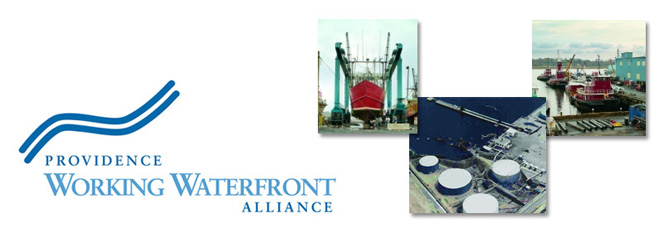The Providence Working Waterfront Alliance would like to respond to Mayor David Cicilline’s comments and conjecture about the impact of Comprehensive Plan changes on working waterfront businesses, as published in today’s “First passage expected for new Comprehensive Plan” article in the Providence Journal.
First, Mayor Cicilline believes there will be no impact on working waterfront area jobs because relocation alternatives are available. We would like to ask the Mayor and Planning Director Thomas Deller to please provide us with a list of possible alternative locations for existing businesses, because we can not envision any. As we have stated previously:
- Most working waterfront businesses must have access to Providence’s 40-foot deep-water port channel to operate.
- There is no developable relocation space available at ProvPort or Fields Point.
- The state has indicated that it does not want heavy industrial uses at Quonset and there is no deep water channel access at this location.
Given this lack of relocation alternatives, we feel strongly that mixed use residential development will mean the loss of working waterfront businesses and jobs. Future condo owners are sure to complain about their industrial neighbors, and these complaints will create political pressure for operating restrictions that will eventually force working waterfront companies out of business.
Second, Mayor Cicilline believes that changing the working waterfront’s Land Use designation to “Mixed Use/Residential” will allow the city to find the “highest and best use for that area.” This myopic vision fails to account for the potential growth that could occur if the city were to maintain the existing industrial only zoning. Why is the Mayor completely closed to encouraging further industrial uses of this area that would take advantage of the port’s unique advantages like the 40-ft deep water channel and easy access to railways and highways? Given huge projected increases in sea based shipping volumes, the Port of Providence’s “highest and best use” could well be as an industrial port. In the absence of any real economic analysis studies comparing possible future land uses, as was conducted during the 1990 Comprehensive Plan process, it is shortsighted to simply assume that “Mixed Use/Residential” is the “highest and best use” for the working waterfront.
Finally, the Mayor singles out the salt pile at Sprague Energy’s Allens Avenue facility as not being a “highest and best use.” Sprague’s Providence salt pile is one of the primary sources of road salt for Rhode Island’s cities and towns. Road salt has to be shipped in and stored somewhere, and Providence’s 40-ft deep water port allows Sprague to meet the area’s road salt needs. Once again, the Mayor’s narrow vision of “highest and best use” precludes a state-wide resource that is incredibly valuable to the safety of Rhode Island drivers during our icy winters.

